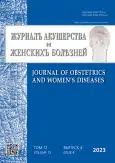Особенности функции печени при преэклампсии
- Авторы: Жесткова Н.В.1,2, Айламазян Э.К.1,2,3, Кузьминых Т.У.1, Марченко Н.В.1,4
-
Учреждения:
- Санкт-Петербургский государственный университет
- Научно-исследовательский институт акушерства, гинекологии и репродуктологии им. Д.О. Отта
- Первый Санкт-Петербургский государственный медицинский университет им. акад. И.П. Павлова
- Российский научный центр радиологии и хирургических технологий им. акад. А.М. Гранова
- Выпуск: Том 72, № 4 (2023)
- Страницы: 59-69
- Раздел: Оригинальные исследования
- URL: https://bakhtiniada.ru/jowd/article/view/253857
- DOI: https://doi.org/10.17816/JOWD409413
- ID: 253857
Цитировать
Аннотация
Обоснование. Несмотря на значительное количество исследований, посвященных проблеме преэклампсии, до настоящего времени многие вопросы, связанные с этиологией, патогенезом и терапией данной патологии, далеки от окончательного решения. Именно поэтому перед акушерами-гинекологами стоит непростая задача выработки рациональной тактики ведения и родоразрешения беременных с преэклампсией с учетом всех рисков для здоровья как матери, так и ее будущего ребенка. Поиск наиболее информативных методов диагностики нарушений функции печени при нарастании тяжести преэклампсии весьма актуален. Гепатобилиарная система несет многофункциональную нагрузку в период гестации и одной из первых реагирует на нарастание тяжести преэклампсии. Чрезвычайно важен выбор приоритетных биохимических показателей крови, отражающих функциональное состояние печени при преэклампсии, способных стать дополнительными критериями для предотвращения материнских и перинатальных осложнений.
Цель исследования — изучить и проанализировать изменения функции печени при преэклампсии, определить критерии развития печеночно-клеточной недостаточности как показателя перехода к тяжелой степени преэклампсии и полиорганной недостаточности.
Материалы и методы. Включены 123 беременные. I группу (n = 40) составили пациентки с преэклампсией без изменений функции печени, II группу (n = 33) — с преэклампсией и нарушением функции печени, III группу (n = 50) — с физиологически протекающей беременностью. Всем беременным выполняли биохимический анализ крови с определением показателей цитолиза (активности аланинаминотрансферазы, аспартатаминотрансферазы и глутаматдегидрогеназы, а также коэффициента де Ритиса), холестаза (активности щелочной фосфатазы и гамма-глютамилтранспептидазы, уровней общего и прямого билирубина и желчных кислот), печеночно-клеточной недостаточности (активности холинэстеразы и лактатдегидрогеназы, уровней общего белка, альбумина и мочевины), а также клинический анализ крови и анализ показателей свертывающей системы крови. Беременных с преэклампсией наблюдали в условиях палаты интенсивной терапии, где осуществляли мониторинг витальных функций.
Результаты. Ведущим синдромокомплексом при нарастании тяжести преэклампсии был цитолитический синдром с умеренным повышением активности трансаминаз (преобладанием активности аланинаминотрансферазы над активностью аспартатаминотрансферазы). В связи с этим коэффициент де Ритиса составил менее 1,0. При развитии печеночно-клеточной недостаточности отмечали преобладание активности аспартатаминотрансферазы над активностью аланинаминотрансферазы (коэффициент де Ритиса был выше 1,33). Выявлено также повышение активности глутаматдегидрогеназы и лактатдегидрогеназы. Среди показателей холестаза отмечено повышение уровня прямого билирубина. Печеночно-клеточную недостаточность характеризовало снижение активности холинэстеразы, а также концентраций общего белка и альбумина. В группе беременных с преэклампсией выявлено статистически значимое снижение уровней гемоглобина и тромбоцитов.
Заключение. Изменение функции печени при преэклампсии отражает нарастание тяжести данного заболевания и свидетельствует о развитии полиорганной недостаточности. В ее терминальной стадии проявляются три синдромокомплекса — цитолитический, холестатический и печеночно-клеточная недостаточность.
Ключевые слова
Полный текст
Открыть статью на сайте журналаОб авторах
Наталья Владимировна Жесткова
Санкт-Петербургский государственный университет; Научно-исследовательский институт акушерства, гинекологии и репродуктологии им. Д.О. Отта
Автор, ответственный за переписку.
Email: zhestkova@me.com
ORCID iD: 0000-0001-8078-3524
SPIN-код: 6014-8153
Scopus Author ID: 57175940900
ResearcherId: N-5303-2015
канд. мед. наук
Россия, Санкт-Петербург; Санкт-ПетербургЭдуард Карпович Айламазян
Санкт-Петербургский государственный университет; Научно-исследовательский институт акушерства, гинекологии и репродуктологии им. Д.О. Отта; Первый Санкт-Петербургский государственный медицинский университет им. акад. И.П. Павлова
Email: ailamazyan@icloud.com
ORCID iD: 0000-0002-9848-0860
SPIN-код: 9911-1160
Scopus Author ID: 6506821393
ResearcherId: G-2219-2014
д-р мед. наук, профессор, засл. деят. науки РФ, академик РАН
Россия, Санкт-Петербург; Санкт-Петербург; Санкт-ПетербургТатьяна Ульяновна Кузьминых
Санкт-Петербургский государственный университет
Email: 9260@mail.ru
ORCID iD: 0000-0002-6136-5324
SPIN-код: 7747-6724
Scopus Author ID: 56719818800
ResearcherId: U-8950-2017
д-р мед. наук, доцент
Россия, Санкт-ПетербургНаталья Валерьевна Марченко
Санкт-Петербургский государственный университет; Российский научный центр радиологии и хирургических технологий им. акад. А.М. Гранова
Email: dr.marchenko@gmail.com
ORCID iD: 0000-0002-6738-6417
SPIN-код: 7262-1746
Scopus Author ID: 55342430200
ResearcherId: O-8777-2014
канд. мед. наук
Россия, Санкт-Петербург; Санкт-ПетербургСписок литературы
- Юсупова З.С., Новикова В.А., Оленев А.С. Современные представления о преэклампсии — патогенез, диагностика, прогнозирование // Практическая медицина. 2018. Т. 16. № 6. С. 45–51. doi: 10.32000/2072-1757-2018-16-6-45-51
- Айламазян Э.К., Зайнулина М.С., Коган И.Ю. и др. Неотложная помощь в акушерстве: руководство для врачей. Москва: ГЭОТАР-Медиа, 2015.
- Шифман Е.М. Преэклампсия. Эклампсия. HELLP-синдром. Петрозаводск, 2002.
- Ивашкин В.Г. Клеточная и молекулярная биология воспаления печени // Российский журнал гастроэнтерологии, гепатологии, колопроктологии. 1999. № 5. С. 13–15.
- Подымова С.Д. Болезни печени. Москва: МИА, 2005.
- Шифман Е.М., Флока Е.И., Вартанов В.Я. Клиническая оценка лабораторных тестов у больных с гестозом // Медицинский курьер. 1992. № 3. С. 56–60.
- Суров А.В. HELLP-синдром в акушерстве // Акушерство и гинекология. 1997. № 6. С. 7–9.
- Abramovici D., Friedman S.A., Mercer B.M., et al. Neonatal outcome in severe preeclampsia at 24 to 36 weeks’ gestation: does the HELLP (hemolysis, elevated liver enzymes, and low platelet count) syndrome matter? // Am. J. Obstet. Gynecol. 1999. Vol. 180. No. 1. Pt. 1. P. 221–225. doi: 10.1016/s0002-9378(99)70178-x
- Паличева Е.И., Артымук Д.А. Современный взгляд на механизмы формирования острой жировой дистрофии печени при беременности // Мать и Дитя в Кузбассе. 2018. № 3. С. 4–11.
- Castro M.A., Goodwin T.M., Shaw K.J., et al. Disseminated intravascular coagulation and antithrombin III depression in acute fatty liver of pregnancy // Am. J. Obstet. Gynecol. 1996. Vol. 174. No. 1. Pt. 1. P. 211–216. doi: 10.1016/s0002-9378(96)70396-4
- Reyes H. Acute fatty liver of pregnancy: a cryptic disease threatening mother and child // Clinics in Liver Disease. 1999. Vol. 3. No. 1. P. 69–81. doi: 10.1016/S1089-3261(05)70054-4
- Галина Т.В., Девятова Е.А., Гагаев Ч.Г. Преэклампсия: новые аспекты патогенеза, концепции скрининга и профилактики // Акушерство и гинекология. Новости. Мнения. Обучение. 2017. № 3(17). С. 66–77.
- Султонова Н.А., Наврузов Э.Р. Факторы риска развития преэклампсии у беременных и пути ее снижения // Наука молодых (Eruditio Juvenium). 2015. № 2. С. 67–74.
- Шерлок Ш., Дули Дж. Заболевание печени и желчевыводящих путей: практическое руководство. Москва, 1999.
- Botros M., Sikaris K.A. The de ritis ratio: the test of time // Clin. Biochem. Rev. 2013. Vol. 34. No. 3. P. 117–130.
Дополнительные файлы







